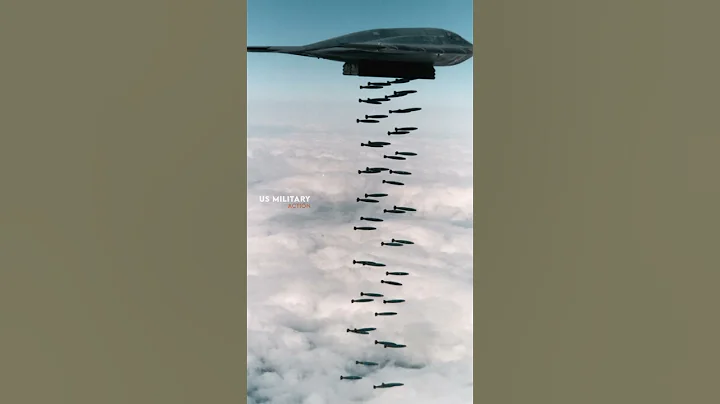Source: Reference Military
Reference News Network reported on February 25 Taiwan's "Central News Agency" Washington reported on February 22 that the U.S. Air Force has begun to retire 17 B-1B strategic bombers that are expensive to maintain, further reducing the number of this specialized aircraft during the Cold War. The fleet size used to deal with the Soviet Union's strategic bombers will save money for future procurement of the B-21 stealth bombers currently under development. The full text is excerpted as follows:
Aviation news website "Flight International" reported that the US military intends to save money and resources and keep the US military's active B-1B fleet at a relatively small scale of 45 aircraft.
B-1B entered service with the United States Air Force in 1985. The aircraft was designed to be able to fly at ultra-low altitudes of only about 60 meters above the ground, maintain high subsonic flight of Mach 0.85, and use airborne terrain tracking and avoidance radar to fly close to the ground at high speed to break through the Soviet air defense network during the Cold War. However, after the Soviet Union launched fighter jets equipped with a "down-looking/down-shooting" radar, it has become very dangerous for the B-1B to perform the above-mentioned strike missions.
With the end of the Cold War, the US military terminated the B-1B's nuclear strike mission in 1994 (according to the US-Russia treaty, the B-1B has dismantled relevant equipment and no longer has the ability to deliver nuclear weapons, this website notes). The B-1B later found a new role in the 2001 War on Terror, providing close air support to U.S. troops in Iraq and Afghanistan (carrying large quantities of precision-guided munitions).
However, the U.S. Air Force stated that the B-1B needs to slow down its flight speed when performing this type of mission. Therefore, the B-1B's variable-sweep main wing must always be in a straight state (minimum sweep angle) rather than maximum sweep (high speed). flight status), causing the main wing to be in a fatigue state for a long time and cause cracks.
Tim Ray, commander of the U.S. Air Force Global Strike Command, said: “Given the attrition of the B-1B fleet over the past 20 years, each bomber costs tens of millions of dollars to maintain normal dispatch capabilities, and this is only the solution. We are just accelerating the original pace of retirement. Of the 17 B-1Bs that will be retired, the US Air Force plans to make four of them "organ donors" as parts for other active B-1Bs. source. The US military plans to keep the remaining B-1B fleet in service until 2040.
[Extended reading] US media: US Air Force B-1B bombers will deploy to Norway for the first time
Reference News Network reported on February 7 The US "Stars and Stripes" website published on February 2 titled "US Air Force Bombers Deployed to Norway for the First Time" According to reports, the U.S. Air Force will deploy B-1B strategic bombers and affiliated logistics units to a base in Norway for the first time, highlighting the growing importance of the Arctic region to U.S. defense strategy. The full text is excerpted as follows:
The U.S. Army European Command said in a statement on the 2nd local time that more than 200 U.S. Air Force personnel from Dyess Air Force Base in Texas are expected to accompany a squadron of B-1B "Lancer" bombers to Austria, Norway. Lan Air Force Base to support U.S. military and allied missions in the region.
The U.S. Army European Command did not specify when these U.S. Air Force personnel and B-1 bombers would arrive at Oran Air Force Base or how long they would be deployed there. Åland Air Force Base is located on the west coast of Norway. The Norwegian Air Force deploys F-35A "Lightning" II stealth fighter jets at the base. The
statement said that these US Air Force personnel "will participate in the advance team of scheduled tasks to be completed within a limited time in the coming weeks."
The U.S. Air Force announced a new Arctic defense strategy in July 2020, which focuses on strengthening its military presence in the region to respond to threats from Russia.
While at Oran Air Force Base, these U.S. Air Force personnel will conduct missions in the Arctic region and work with allies and partners in the European theater.
Jeff Harrigian, commander of U.S. Air Forces Europe and Africa, said in a statement: "Maintaining readiness and the ability to support and respond quickly to allies and partners is critical to our mutual success. We value our partnership with Norway long-term partnership and look forward to future opportunities to strengthen our mutual defense.”
A spokesperson for the U.S. Air Force Command in Europe and Africa said on the 2nd local time that this is the first time the U.S. military has deployed strategic bombers to Norway.
During the peak of the Cold War, U.S. strategic bombers often appeared in the area.Although bombers such as B-52s and F-111s were stationed in neighboring Britain, they were unable to use air bases in Norway or even participate in exercises because the Oslo government banned aircraft with "nuclear capabilities" (delivering nuclear weapons, note from this website). Allied military aircraft use its territory.
Before the mid-1990s, the B-1B long-range bomber had always had "nuclear capabilities." Later, this bomber underwent relevant modifications (dismantling nuclear weapons delivery equipment) in accordance with the provisions of the U.S.-Soviet Nuclear Weapons Limitation Treaty, and specialized in performing conventional bombing missions.
The B-1B Lancer supersonic strategic bomber nicknamed "Bone" has been in service with the United States Air Force since 1985. (Compiler/Guo Jun)

Data picture: In February this year, U.S. B-1B bombers and Norwegian Air Force fighter jets conducted joint training in the Arctic region. (U.S. Air Force official website)
(2021-02-07 16:50:19)
[Extended reading] The U.S. military uses B-1B bombers to show off its global strike capabilities and frequently holds joint exercises with allies
Reference News Network reported on June 3 U.S. According to media reports, in recent times, the US military has frequently used B-1B bombers to show off its global strike capabilities and held joint exercises with allies in Europe, Asia-Pacific and other regions.
According to a report on the US military website on June 1, Last week (May 29, local time), two B-1B "guns" of the 28th Bomb Wing of the US Air Force from Ellsworth Air Force Base in South Dakota, US Cavalry strategic bombers conducted their first joint flight with Su-27 and MiG-29 fighter jets of the Ukrainian Air Force over the Black Sea. According to officials from the United States Air Force in Europe (USAFE) on the 1st, the B-1B also conducted training on launching AGM-158C long-range anti-ship missiles.
Lt. Col. Timothy Albrecht of USAFE's 603rd Air Operations Center said: "The rise of near-peer competitors and heightened tensions between NATO and our adversaries has brought air anti-ship capabilities back to the strategic bomber force. At the forefront of maritime combat missions"
At the same time, Albrecht, a mission planner for the US Air Force Bomber Task Force, said in a press release: "Due to the enhanced ability to distinguish targets from long distances, the AGM-158C Long-range anti-ship missiles can play a key role in ensuring that the U.S. Navy can enter high seas and littoral environments to carry out operations.”

Data photo: Ukrainian Air Force Su-27 fighter jets escort a U.S. B-1B bomber formation. (U.S. Air Force official website)
 html On May 29, the Russian Ministry of Defense showed a schematic diagram of two U.S. B-1B bombers (blue area) launching anti-ship missiles over the Black Sea. (Official website of the Russian Ministry of Defense)
html On May 29, the Russian Ministry of Defense showed a schematic diagram of two U.S. B-1B bombers (blue area) launching anti-ship missiles over the Black Sea. (Official website of the Russian Ministry of Defense) reported that an official recently told a reporter from a US military website that the deployment of AGM-158C long-range anti-ship missiles in exercises is an integral part of the US Air Force's larger concept of "global strike": as B-1B bombers As part of the formation's "restart" mission, the Air Force has not only made its B-1B supersonic heavy bombers more visible by flying multiple flights around the world, it has also resumed having them practice long-range precision strikes - especially in Pacific region--this marks a major shift after U.S. military strategic bombers have performed "close air support" missions in the Middle East for many years.
USAFE said on Twitter that in addition to Polish, Romanian, Greek and North Macedonian fighter aircraft, Turkish KC-135 tanker aircraft also participated (en route) in joint training operations between US bombers and Ukrainian military aircraft over the Black Sea to carry out a "Long-range, long-duration strategic bomber task force missions across Europe and the Black Sea region."
According to a report on May 30 on the US bimonthly website "The National Interest", earlier in May, two B-1B "Lancer" bombers flew from Andersen Air Force Base in Guam to Alaska and returned to the base. In Alaska, the two B-1Bs conducted a "large force deployment exercise" at the Pacific Alaska Joint Range Range. According to a press release issued by the U.S. Air Force, the two B-1Bs then flew southwest to Japan and "completed familiarization training" in Japan. Subsequently, the two B-1Bs "continued to fly south to Misawa, Japan, and teamed up with the USS Ronald Reagan aircraft carrier and a P-8 Poseidon patrol aircraft to conduct long-range anti-ship missile training , return to Guam after training.”

File photo: Japanese Air Force F-2 fighter jets escort a U.S. B-1B bomber formation. (U.S. Air Force official website)
According to multiple online air traffic control monitoring agencies, the two B-1B bombers flew through the Sea of Okhotsk, which is a continental sea on Russia’s southeastern border near Japan. This move That is to issue a clear challenge to Russia, similar to the "freedom of navigation" operations carried out by the United States in the South China Sea.
U.S. media reported that although the B-1B bomber became famous for its effective role as a "close air support platform" in Afghanistan, the bomber was originally designed to serve as a supersonic missile with nuclear strike capabilities for the United States during the Cold War. bomber.
Commenting on the above-mentioned press release, a U.S. Air Force official said that the B-1B bomber mission was designed to "demonstrate our ability to threaten any target at any time, anywhere."
reported that because Guam is located in the Western Pacific, it is particularly effective for Guam to have the ability to strike anywhere. Guam is the westernmost U.S.-administered territory and therefore the U.S.’s closest point to the South China Sea — and to China.
(2020-06-03 12:18:25)
[Extended reading] Support allies? Multinational fighter jets escorted U.S. B-1B bombers as they cruised Eastern Europe

According to the U.S. Air Force official website, recently, the U.S. Air Force dispatched multiple B-1B strategic bombers from the Ellsworth Base in the mainland, flying over multiple NATO allies in Eastern Europe and the Black Sea region. Conducting joint long-distance attack training has a certain rhythm of "supporting" allies. The picture shows a formation of Polish Air Force F-16 fighter jets escorting a US B-1B bomber.

The Crane Air Force dispatched Su-27 heavy fighter jets to escort the US B-1B bombers.

The Romanian Air Force dispatched US-made F-16 fighter jets to escort the US B-1B.

Polish Air Force F-16 fighters and U.S. military B-1B bombers fly in joint formation.

Polish Air Force F-16 fighter jets accompany US B-1B bombers.
(2020-06-01 14:29:00)





















